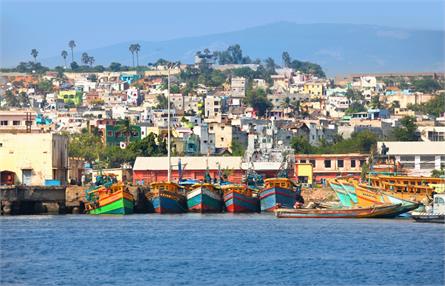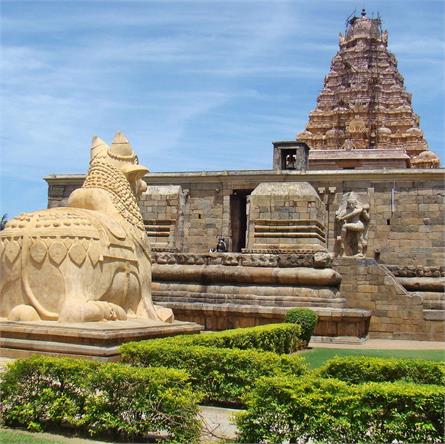Monuments at Mahabalipuram: Narrative Of The Past

The Group of Monuments at Mahabalipuram, located on the Coromandel Coast of the Bay of Bengal in Tamil Nadu, India, is a UNESCO World Heritage Site. This collection of 7th and 8th-century CE religious monuments is a testament to India's rich history, culture, and architectural prowess. Mahabalipuram is conveniently located about 60 kilometers south of Chennai, Tamil Nadu. It is easily accessible via the East Coast Road and Rajiv Gandhi Salai. The nearest airport is Chennai International Airport (IATA airport code MAA), and the town is well-connected to the rest of India through a rail network.
Also Read: UNESCO World Heritage Sites in India
Nomenclature of Mahabalipuram | Several Names of Mahabalipuram
Mahabalipuram is known by several names, including Mamallapuram, derived from "Mamalla," which means "Great Wrestler." This title is a reference to the 7th-century king Narasimha Varman I, also known as Mamalla, who played a significant role in the region's history. The town has been referred to as Mamallapattana, Mavalipuram, Mavalivaram, Mavellipore, Mauvellipooram, and Mahabalipur, all of which signify a "great wrestler city" or "city of Mahabali." The latter name, Mahabalipur, is linked to the mythological demon king Mahabali, who was defeated by the dwarf avatar of Vishnu, Vamana.
Also Read: Andaman and Nicobar Islands - The Serene Pearl Garland
Seven Pagodas
The town earned the moniker "Seven Pagodas" during the time of European sailors who witnessed the distinctive towers of seven Hindu temples along the coast. While ancient inscriptions from the 7th century referred to it as "Mamallapuram," the name "Mahabalipuram" only gained prominence after the 16th century. In 1957, the Tamil Nadu government officially adopted the name "Mamallapuram" for the site and township.
Also Read: Visakhapatnam - The Jewel of East Coast
Historical Significance of Mahabalipuram
The ancient history of Mahabalipuram is shrouded in mystery, but evidence suggests its significance long before the construction of the monuments. It is speculated to be the seaport of Sopatma mentioned in the 1st-century Periplus of the Erythraean Sea or Ptolemy's port of Melange in the 2nd-century Geographia. Another theory suggests that the port of Nirppeyarvu mentioned in the Perumpanarrupadai from the late 19th century to the early 20th century may correspond to Mahabalipuram or Kanchipuram.
Even in ancient texts, Mahabalipuram held cultural and historical importance. The 7th–8th century Sanskrit scholar Daṇḍin, associated with the Pallava court, praised the artists of Mahabalipuram for their repair work on a Vishnu sculpture. This text also highlighted the early tradition of repairs and the significance of Vaishnavism in the region.
The Venetian explorer Marco Polo mentioned "Seven Pagodas" when he visited India, referring to the shore temples of Mahabalipuram. This name later appeared on maps such as Abraham Cresques' 1375 Catalan Atlas. Gasparo Balbi, another Venetian traveler, mentioned the "Seven Pagodas" and "Eight Pleasant Hillocks" in 1582. However, the exact origins and meanings of these names have led to much speculation and debate.
In more recent history, the December 2004 tsunami exposed parts of Mahabalipuram's beachfront, revealing inscriptions and structures. Some of these artifacts were dated to the 9th century and may have been destroyed by a 13th-century tsunami. Marine archaeologists and diving teams also explored the underwater site east of the Shore Temple, revealing fallen walls, rectangular blocks, and other structures alongside the surviving monuments.
Also Read: Chhattisgarh - The Bowl of Minerals
Modern Reports and Research
European sailors and merchants who engaged in trade with Asia in the 16th century mentioned Mahabalipuram, although early reports often confused the architectural styles with Chinese and Burmese Buddhist pagodas. Some even speculated that the temples were built by the Chinese. These early accounts offer valuable insights into the Western world's fascination with the exotic and ancient wonders of India.
In the 18th century, William Chambers' literary survey of Mahabalipuram drew attention to the monuments, connecting them to Hindu texts and praising their remarkable narrative detail. 19th-century studies, such as those by Benjamin Babington and William Elliot, provided sketches of the monuments and impressions of the inscriptions. However, some Western literature of that time continued to present unusual stories and speculations, such as Francis Wilford's suggestion in 1809 that the monuments dated back to 450 BCE.
During the late 19th and early 20th centuries, Mahabalipuram became a focal point for colonial-era tourism and speculation. Unfortunately, parts of the monuments were covered with sand during this period, and little effort was made to preserve the site.
After India gained independence, the Tamil Nadu government recognized the historical and cultural significance of Mahabalipuram. They developed the Mamallapuram monuments and the coastal region as an archaeological, tourism, and pilgrimage site. In 1984, the site was designated a UNESCO World Heritage Site, further highlighting its global importance.
Also Read: Churches and Convents of Goa The UNESCO Heritage
Archaeological Interest and Discoveries
Since 1990, the Group of Monuments at Mahabalipuram has been a subject of archaeological interest. Excavations at the site have yielded unexpected discoveries that provide valuable insights into the region's history and culture. Notably, an apsidal-shaped tank was uncovered, with its curved end aligned south toward the middle portion of the Shore Temple. This tank likely predates the temple and may have served a religious or practical purpose.
Also Read: Agra Fort, India's Majestic Jewel of Mughal Architecture
Pallava Construction
The Pallava dynasty played a crucial role in the construction of the monuments at Mahabalipuram. The town's prominence can be traced back to the reign of Simhavishnu during the late 6th century. This period was marked by political competition with neighboring dynasties like the Pandyas, Cheras, and
Cholas, as well as a spiritual awakening with the rise of Bhakti movement poet-scholars known as the Vaishnava Alvars and Shaiva Nayanars.
The architecture of Mahabalipuram is closely linked to Simhavishnu's son, Mahendravarman I, who was a patron of the arts. Mahendravarman's son, Narsimha Varman I, furthered his father's efforts and is attributed to the construction of many of the monuments. Subsequently, temple and monument construction continued during the reign of Rajasimha (Narasimhavarman II).
Scholars have categorized Pallava architecture at Mahabalipuram into various styles and periods, including Mahendra (610-640), Mamalla (640-670), Rajasimha (674-800), and Nandivarman (800-900). The chronological ordering of these styles has been a subject of debate, with some scholars suggesting that the earliest temples date back to around 600 CE.
One significant piece of evidence supporting this early dating is the Mandagapattu inscription (Laksitayana inscription) of Mahendravarman I. This inscription highlights the construction of a temple dedicated to "Brahma, Vishnu, and Shiva" without the use of timber, lime, brick, or metal. This inscription is seen as a crucial indicator of the region's temple construction tradition that predated the 6th century.
Also Read: Araku Valley - Coffee Pot of India
Description of Monuments
The monuments at Mahabalipuram are a magnificent fusion of religion, culture, and legend, beautifully carved into stone. They exist on a grand scale and seamlessly integrate nature and sculpture. The site comprises approximately forty monuments, each with its unique significance and purpose.
These monuments are divided into five groups:
- Rathas: Chariot-shaped temples
- Mandapas: Cave temples
- Rock reliefs
- Structural temples
- Excavations
1. Rathas: Chariot-shaped temples
The Rathas, often referred to as chariot-shaped temples, are notable for their use of naturally-occurring blocks of diorite and granite in sand. The most famous among these is the Five Rathas, although these are not dedicated to the Pandavas as the name might suggest. Instead, they are temples devoted to deities and concepts of the Shaivi (Shiva), Vaishnavi (Vishnu), and Shakti (Durga) traditions of Hinduism. These Rathas date back to the 7th century and are characterized by their distinctive shapes and intricate carvings.
Also Read: Goa - Beat Beach Treat
2. Mandapas: Cave temples
The Mandapas, or cave temples, are another highlight of Mahabalipuram. These caves feature narratives from Hindu epics like the Mahabharata and contain inscriptions in various Indian languages and scripts. The rock-cut architecture of these temples is a marvel in itself, showcasing the artistry and craftsmanship of the Pallava dynasty.
3. Rock reliefs
Rock reliefs are an essential part of Mahabalipuram's monuments, particularly the famous "Descent of the Ganges" or "Arjuna's Penance." This open-air rock relief is one of the largest in the world and depicts a powerful scene from Hindu mythology. It serves as a canvas for various intricate carvings and narratives.
4. Structural temples
Structural temples, built between 695 and 722 CE, stand as testaments to the architectural prowess of the Pallavas. The Shore Temple, a significant structural temple, is a prime example of this architectural excellence. Its location along the coast adds to its allure, and it remains a symbol of Mahabalipuram's grandeur.
5. Excavations
Excavations at Mahabalipuram have unearthed a treasure trove of historical artifacts and structures. These discoveries shed light on the town's ancient history and provide valuable insights into its past.
Also Read: The Architectural Work of Le Corbusier
The Group of Monuments at Mahabalipuram stands as a remarkable testament to India's rich history and cultural heritage. These 7th and 8th-century CE religious monuments, built under the patronage of the Pallava dynasty, showcase exquisite craftsmanship and intricate carvings. The site's historical significance, coupled with its UNESCO World Heritage status, makes it a must-visit destination for history enthusiasts, archaeologists, and tourists from around the world.
Also Read: Visakhapatnam - The Jewel of East Coast
As we delve into the mysteries and marvels of Mahabalipuram, we gain a deeper appreciation for the ancient traditions, legends, and architectural wonders that continue to captivate our imagination. Whether exploring the chariot-shaped Rathas, meditating in the cave temples, or admiring the rock reliefs, Mahabalipuram offers a journey through time, where history and mythology come to life amidst the timeless beauty of stone.










